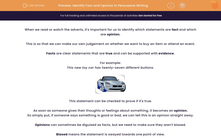When we read or watch the adverts, it's important for us to identify which statements are fact and which are opinion.
This is so that we can make our own judgement on whether we want to buy an item or attend an event.
Facts are clear statements that are true and can be supported with evidence.
For example:
This new toy car has twenty-seven different buttons.

This statement can be checked to prove if it's true.
As soon as someone gives their thoughts or feelings about something, it becomes an opinion.
So simply put, if someone says something is good or bad, we can tell this is an opinion straight away.
Opinions can sometimes be diguised as facts, but we need to make sure they aren't biased.
Biased means the statement is swayed towards one point of view.
For example:
The toy car will make all your friends jealous with its shiny exterior.
This almost sounds like a fact but this is biased - maybe it is the view of the people who want to sell it to you!
It isn't a fact and not everyone will be jealous.
In this activity, you'll read a persuasive text and separate the facts from the opinons.








